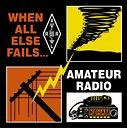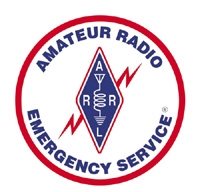
 SUMTER COUNTY
SUMTER COUNTY
Amateur Radio Emergency Services Association (ARES)
Sumter County, Florida
Pets and Animals

Our pets enrich our lives in more ways than we can count. In turn, they depend on us for their safety and well-being. Here's how you can be prepared to protect your pets when disaster strikes.
Be Prepared with a Disaster Plan
The best way to protect your family from the effects of a disaster is to have a disaster plan. If you are a pet owner, that plan must include your pets. Being prepared can save their lives.
Different disasters require different responses. But whether the disaster is a hurricane or a hazardous spill, you may have to evacuate your home.
In the event of a disaster, if you must evacuate, the most important thing you can do to protect your pets is to evacuate them, too. Leaving pets behind, even if you try to create a safe place for them, is likely to result in their being injured, lost, or worse. So prepare now for the day when you and your pets may have to leave your home.
- Have a Safe Place To
Take Your Pets
Some County storm shelters cannot accept pets because of states' health and safety regulations and other considerations; however there are others that can and know where they are. Service animals who assist people with disabilities are the only animals allowed in all storm shelters. It may be difficult, if not impossible, to find shelter for your animals in the midst of a disaster, so plan ahead. Do not wait until disaster strikes to do your research.- Contact hotels and motels outside your immediate area to check policies on accepting pets and restrictions on number, size, and species. Ask if "no pet" policies could be waived in an emergency. Keep a list of "pet friendly" places, including phone numbers, with other disaster information and supplies. If you have notice of an impending disaster, call ahead for reservations.
- Ask friends, relatives, or others outside the affected area whether they could shelter your animals. If you have more than one pet, they may be more comfortable if kept together, but be prepared to house them separately.
- Prepare a list of boarding facilities and veterinarians who could shelter animals in an emergency; include 24-hour phone numbers.
- Ask local animal shelters if they provide emergency shelter or foster care for pets in a disaster. Animal shelters may be overburdened caring for the animals they already have as well as those displaced by a disaster, so this should be your last resort.
- Things to Consider Doing
- Locate a veterinarian or animal hospital in the area where you may be seeking temporary shelter, in case your pet needs medical care. Add the contact information to your emergency kit.
-
Have your pet microchipped and make sure that you not only keep your address and phone number up-to-date, but that you also include contact info for an emergency contact outside of your immediate area.
-
Call your local emergency management office, animal shelter or animal control office to get advice and information.
-
If you are unable to return to your home right away, you may need to board your pet. Find out where pet boarding facilities are located.
-
Most boarding kennels, veterinarians and animal shelters will need your pet's medical records to make sure all vaccinations are current.
- Assemble a Portable Pet Disaster Supplies Kit
Whether you are away from home for a day or a week, you'll need essential supplies. Keep items in an accessible place and store them in sturdy containers that can be carried easily (duffle bags, covered trash containers, etc.). Your pet disaster supplies kit should include:- Medications and medical records (stored in a waterproof container) and a first aid kit.
- Sturdy leashes, harnesses, and/or carriers to transport pets safely and ensure that your animals can't escape.
- Current photos of your pets in case they get lost.
- Food, potable water, bowls, cat litter/pan, and can opener.
- Information on feeding schedules, medical conditions, behavior problems, and the name and number of your veterinarian in case you have to foster or board your pets.
- Pet beds and toys, if easily transportable.
- Know What To Do As a
Disaster Approaches
- Often, warnings are issued hours, even days, in advance. At the first hint of disaster, act to protect your pet.
- Call ahead to confirm emergency shelter arrangements for you and your pets.
- Check to be sure your pet disaster supplies are ready to take at a moment's notice.
- Bring all pets into the house so that you won't have to search for them if you have to leave in a hurry.
- Make sure all dogs and cats are wearing collars and securely fastened, up-to-date identification. Attach the phone number and address of your temporary shelter, if you know it, or of a friend or relative outside the disaster area. You can buy temporary tags or put adhesive tape on the back of your pet's ID tag, adding information with an indelible pen.
You may not be home when the evacuation order comes. Find out if a trusted neighbor would be willing to take your pets and meet you at a prearranged location. This person should be comfortable with your pets, know where your animals are likely to be, know where your pet disaster supplies kit is kept, and have a key to your home. If you use a petsitting service, they may be available to help, but discuss the possibility well in advance.
Planning and preparation will enable you to evacuate with your pets quickly and safely, but bear in mind that animals react differently under stress.
- Outside your home and in the car, keep dogs securely leashed.
- Transport cats in carriers.
- Don't leave animals unattended anywhere they can run off. The most trustworthy pets may panic, hide, try to escape, or even bite or scratch.
- When you return home, give your pets time to settle back into their routines.
- Consult your veterinarian if any behavior problems persist.
5. Tips for Large Animals
If you have large animals such as horses, cattle, sheep, goats or pigs on your property, be sure to prepare before a disaster.
- Ensure all animals have some form of identification.
- Evacuate animals whenever possible. Map out primary and secondary routes in advance.
- Make available vehicles and trailers needed for transporting and supporting each type of animal. Also make available experienced handlers and drivers.
- Ensure destinations have food, water, veterinary care and handling equipment.
- If evacuation is not possible, animal owners must decide whether to move large animals to shelter or turn them outside.
Take extra time to observe livestock, looking for early signs of disease and injury. Severe cold-weather injuries or death primarily occur in the very young or in animals that are already debilitated.
Make sure your livestock has the following to help prevent cold-weather problems:
- Plenty of dry bedding to insulate vulnerable udders, genitals and legs from the frozen ground and frigid winds
- Windbreaks to keep animals safe from frigid conditions
- Plenty of food and water
6. About Other Pets
Birds
Birds should be transported in a secure travel cage or carrier. In cold weather, wrap a blanket over the carrier and warm up the car before placing birds inside. During warm weather, carry a plant mister to mist the birds' feathers periodically. Do not put water inside the carrier during transport. Provide a few slices of fresh fruits and vegetables with high water content. Have a photo for identification and leg bands. If the carrier does not have a perch, line it with paper towels and change them frequently. Try to keep the carrier in a quiet area. Do not let the birds out of the cage or carrier.Reptiles
Snakes can be transported in a pillowcase but they must be transferred to more secure housing when they reach the evacuation site. If your snakes require frequent feedings, carry food with you. Take a water bowl large enough for soaking as well as a heating pad. When transporting house lizards, follow the same directions as for birds.Pocket Pets
Small mammals (hamsters, gerbils, etc.) should be transported in secure carriers suitable for maintaining the animals while sheltered. Take bedding materials, food bowls, and water bottles.A Final Word
If you must evacuate, do not leave your animals behind. Evacuate them to a prearranged safe location if they cannot stay with your during the evacuation period. (remember, pets are not allowed in Red Cross shelters.) If there is a possibility that disaster may strike while you are out of the house, there are precautions you can take to increase your pets' chances of survival, but they are not a substitute for evacuating with your pets
Build a Kit
Include basic survival items and items to keep your pet happy and comfortable.
-
Food. At least a three day supply in an airtight, waterproof container.
-
Water. At least three days of water specifically for your pets.
-
Medicines and medical records.
-
Important documents. Registration information, adoption papers and vaccination documents. Talk to your veterinarian about microchipping and enrolling your pet in a recovery database.
-
First aid kit. Cotton bandage rolls, bandage tape and scissors; antibiotic ointment; flea and tick prevention; latex gloves, isopropyl alcohol and saline solution. Including a pet first aid reference book is a good idea too.
-
Collar or harness with ID tag, rabies tag and a leash.
-
Crate or pet carrier. Have a sturdy, safe crate or carrier in case you need to evacuate. The carrier should be large enough for your pet to stand, turn around and lie down.
-
Sanitation. Pet litter and litter box if appropriate, newspapers, paper towels, plastic trash bags and household chlorine bleach.
-
A picture of you and your pet together. If you become separated, a picture of you and your pet together will help you document ownership and allow others to assist you. Add species, breed, age, sex, color and distinguishing characteristics.
- Familiar items. Familiar items, such as treats, toys and bedding can help reduce stress for your pet.

REFERENCES
Preparing Makes Sense for Pet Owners - Emergency Preparedness Pet Kit List (PDF)
FEMA: Pet (PDF)
Hurricane Preparation for Horse Owners (PDF)
Last Update: 06/02/2018 © Copyright Sumter County ARES. All Rights Reserved.